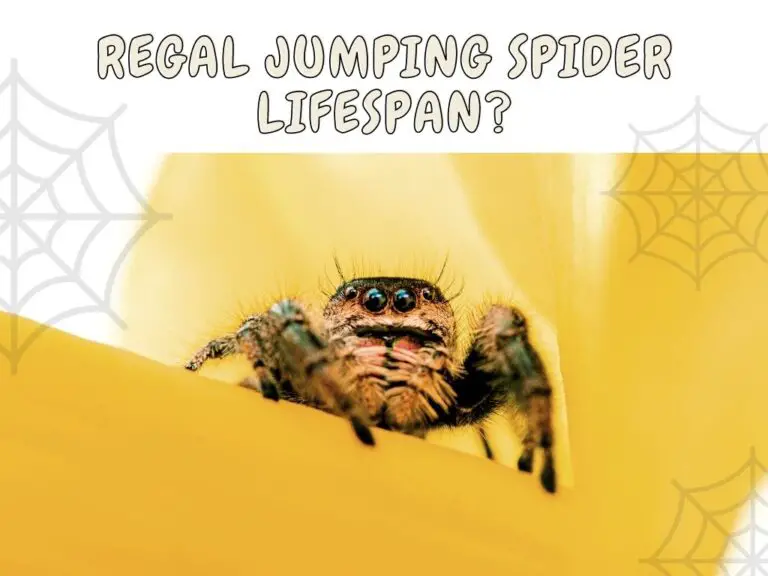The regal jumping spider is a unique species of jumping spiders. This creature boasts of a lot of special characteristics that make it easy to identify. To start with, the regal jumping spider belongs to the salticidae family.
Because of its unique colouration, the male regal spider is often confused for a black widow. In terms of size, this jumping spider species is recognized as the largest jumping spider you’ll find in North America.
Today, regal spiders can be found in the Greater Antilles, the Bahamas, Southern US, and in peninsular Florida. Now, the big question is, how long can regal jumping spiders survive? Read on as we take you through everything you need to know about regal jumping spiders and their lifespan.
Physical description of the regal jumping spider
Wondering what a regal jumping spider looks like? Here, checkout some physical descriptions of this exotic pet.
- Size: In terms of size, the female regal spider measures between 0.28-0.87 inches. On the flip side, the male regal spider measures around 0.24-0.71 inches.
- Color: Female regal jumping spiders are easy to identify as they are either gray or orange in color. And in addition to these colors, they sometimes have stripes and spots. Like their female counterparts, the male regal jumping spider has almost the same pattern; the only difference is that they have some white stripes and spots on their black bodies. Other prominent features include brilliant shades of violet, blue and purple iridescence.
Their eggs
For those who have no idea, the female regal jumping spider is thought to lay eggs four times during her lifetime. And for the first time, the egg appears to be big. That said, the number of eggs she lays decreases as she ages.
It’s important to note that female regal spiders lay eggs that are nicely laid in silk cocoons, either under pine trees or oak tree barks.
About their spiderlings
Although there is abundant information about regal jumping spiders, not much is known about juvenile regal jumping spiders. But as time and studies progress, we hope to learn more about juvenile regal jumping spiders.
Do regal jumping spiders spin webs?
Like other spiders, the regal jumping spider can spin elliptic webs using two emergency exits located on either side of its body. The only difference is that it doesn’t use its web for capturing prey. Instead, its web is used for fostering juvenile regal jumping spiders. Also, the web acts as an anchor whenever it jumps and misses its target.
Are regal jumping spiders poisonous?
There have been many arguments regarding whether regal jumping spiders are poisonous or not. But let’s quash all those arguments, shall we? The thing is, regal jumping spiders only bite when they are held tightly or feel threatened. So, if you handle them with care, you should be just fine.
And even if you get bitten, their venom isn’t harmful to humans. Sure, you may notice redness and irritations, but this usually fades away after a couple of days.
What is the lifespan of regal jumping spiders?
Just like other species of spiders, the regal jumping spider has a very short lifespan. As a matter of fact, these creatures are billed to survive for only ten months. Also, the females are known to have a longer lifespan than their male counterparts.
What do regal jumping spiders eat?
Giving their impeccable jumping skills and hunting instinct, the regal jumping spider can hunt and fend for itself in the wild. But if they are kept in captivity, they rely on their owners to feed properly.
And just like other spider species, the regal jumping spider typically feeds on insects that are smaller than it. Sure, they can feed on bigger insects like crickets, but sometimes, larger prey can harm or even kill them.
For those wondering what they can feed their regal jumping spider, here is a list of prey you can serve regal jumping spiders.
- Crickets
- Flies
- Mealworms
- Roaches
The cool part is that these spider foods are readily available and can be gotten from pet stores around you. Also, you can order them online if that’s more convenient for you.
What you should never feed a regal jumping spider
Having mentioned some preys you can serve your spider friend, here are some not so cool insects you should never serve your spider friend:
- Beetles
- Other spiders
- Fireflies
- Ants
These aforementioned preys can be poisonous and aggressive towards your furry friend. Even tiny ants can bite or spray acids that are lethal to your spider friend.
Sure, these insects may not bother you, but guess what? They are capable of harming your spider.
Do regal jumping spiders drink water?
Spiders like to drink water, so it’s okay to offer droplets of water to your fuzzy friend every now and then. You can serve water when offering food. When serving water, you can use a spray bottle to wet the sides of the enclosure. Try to avoid spraying directly, as you may end up drowning your exotic pet.
A lot of people have asked if they need special water. While this is a tough question, we have used tap water without any problems.
Frequently asked questions
Are regal jumping spiders dangerous?
While regal jumping spiders have venoms that can incapacitate their prey, they are not considered dangerous to humans. And even if you get bitten by this spider, you’ll only notice redness and irritations that disappear after a few days.
Can you keep a jumping spider as a pet?
Because of their friendly nature and fun personalities, jumping spiders can be raised as pets. When raised in captivity, make sure their enclosure has enough space to let them roam around. Also, endeavor to feed them properly.
Can you keep multiple spiders in one enclosure?
As a rule of thumb, never keep more than one spider in a tank. Doing so is a recipe for disaster as these creatures will fight to the death.
Conclusion
Like all other spiders, the regal jumping spider has a short lifespan and can survive for up to 10 months. That said, it is easy to care for and maintain. And because it is friendly, you can keep it as a pet.
- How To Catch A Jumping Spider – Everything You Need To Know
- Are Jumping Spiders Good Pets – Are They Safe To Own
- Do Jumping Spiders Live in California – Top 2 Species
- What Eats Jumping Spiders – Which Part Of The Food Chain
- Is A Jumping Spider Poisonous – Do You Need To Fear?
- Jumping Spider Bite Symptoms – Is It Harmful?




